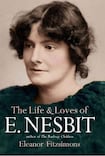
When Noël Coward was a small boy, he was so desperate to read one of E Nesbit’s books that he stole a necklace from a friend of his mother, sold it, and used the proceeds to buy a copy. In the early 1920s Coward bought a cottage near the Kent coast and was thrilled to discover that his childhood heroine was one of his new neighbours. The promising young playwright and the now frail older woman became friendly, and he told her she had inadvertently driven him to crime in his youth. “I regret to say,” wrote Coward in his 1934 memoir, Present Indicative, “that she was delighted”.
If, like Coward – and like me – you grew up on the books of E Nesbit, this is just how you would hope the creator of the Bastables and the Psammead would react to such a confession. At the dawn of the 20th century, Nesbit essentially created modern children’s fiction, writing sophisticated, hilarious, wildly imaginative stories full of child characters who acted, spoke, argued and thought like real children. Although her poetry, of which she was very proud, now seems almost painfully of its time, her children’s stories have lost little of their vitality and freshness; as Noel Streatfeild wrote, one would recognise the Bastables today if one saw them on the bus.
She was undeniably charismatic, a sociable chain smoker in Liberty 'rational' dress who loved to host large gatherings of her creative socialist friends
Nearly a century after her death in 1924, it is astonishing that until now there have only been two serious biographies of the woman who can justifiably be described as the most significant children’s author of the 20th century. Doris Langley Moore’s E Nesbit was written in 1933, when many of Nesbit’s friends and relatives were still alive and available for interview. Julia Briggs’s 1987 E Nesbit: A Woman of Passion was thorough if a little dry. Both have been out of print for years.
Peripatetic childhood
All of this makes Irish writer Eleanor Fitzsimon’s insightful and lively new biography even more welcome. The comparative neglect is all the more surprising when one considers the extraordinary facts of Nesbit’s life. After a peripatetic childhood, Edith fell for a young clerk with progressive ideas called Hubert Bland; when they married in 1880, she was seven months pregnant. Both Nesbit and Bland had literary ambitions, and after a business venture failed they began collaborating on stories that they sold to magazines.
They were also founding members of the Fabian Society. Fellow Fabian socialist George Bernard Shaw became a close friend of Nesbit’s although, like most of her friends, he found her frustrating at times. She was undeniably charismatic, a sociable chain smoker in Liberty “rational” dress who loved to host large gatherings of her creative socialist friends. “If you aren’t a lady,” Nesbit once advised her young friend Berta Ruck, “don’t try to be one. Much better stay a free and happy bounder.”
As Hubert built up his career as a political commentator, Nesbit was the family breadwinner. She churned out poems and illustrations and stories, sometimes with the help of her friend Alice Hoatson, who moved in with the Blands and their young children. Hoatson would stay there for over two decades, a period in which Nesbit’s literary star would soar – and fall, leaving her in financial difficulties.
There is no doubt that she was a generous and kind friend, but Fitzsimons shows that she could be difficult to deal with, too
Hubert’s commitment to socialist ideals was combined with a massive ego (a friend of Nesbit’s said that if she wanted to leave a note for her husband, she would “stick it in the frame of the looking glass where he would be sure to notice it”). He embarked on a relationship with Hoatson, who had two children by him. Nesbit acknowledged the children as her own, with Alice living with them as a sort of aunt figure.
Too many names
Finding explicit similarities between an author’s work and their life can feel forced, but Fitzsimons makes extensive and excellent use of Nesbit’s fiction and poetry, and in doing so she illuminates both Nesbit’s work and her life. At times the narrative trembles under the sheer weight of names, though that isn’t the biographer’s fault; so many friends and potential lovers came in and out of Nesbit’s highly sociable life that it can be hard for the reader to keep track of them all.
There is no doubt that she was a generous and kind friend, but Fitzsimons shows that she could be difficult to deal with, too. And despite her socialism and her successful career and her clever, active young female characters, she shared many of Hubert’s views on women’s “natural role” as wives and mothers, giving a speech on the subject at the Fabian Women’s Group that enraged her audience. These contradictions, as Fitzsimon shows, can be found in her writing too. Like all the best literary biographies, this highly readable book will send readers back to that writing. Some 120 years after The Story of The Treasure Seekers changed children’s literature forever, E Nesbit’s work and life retain their ability to fascinate and amuse.













